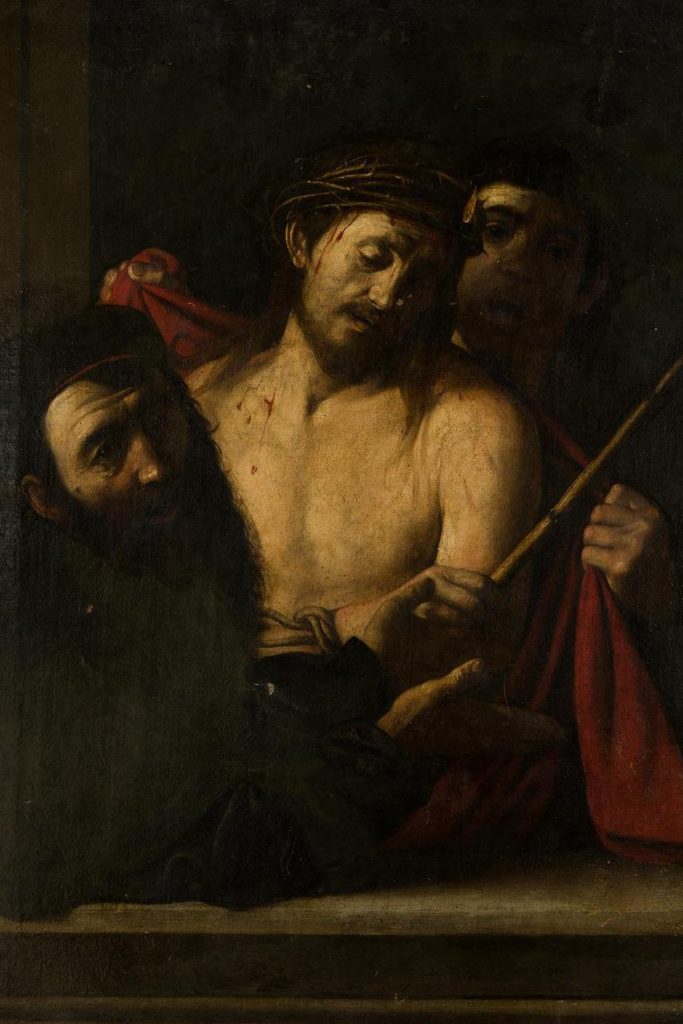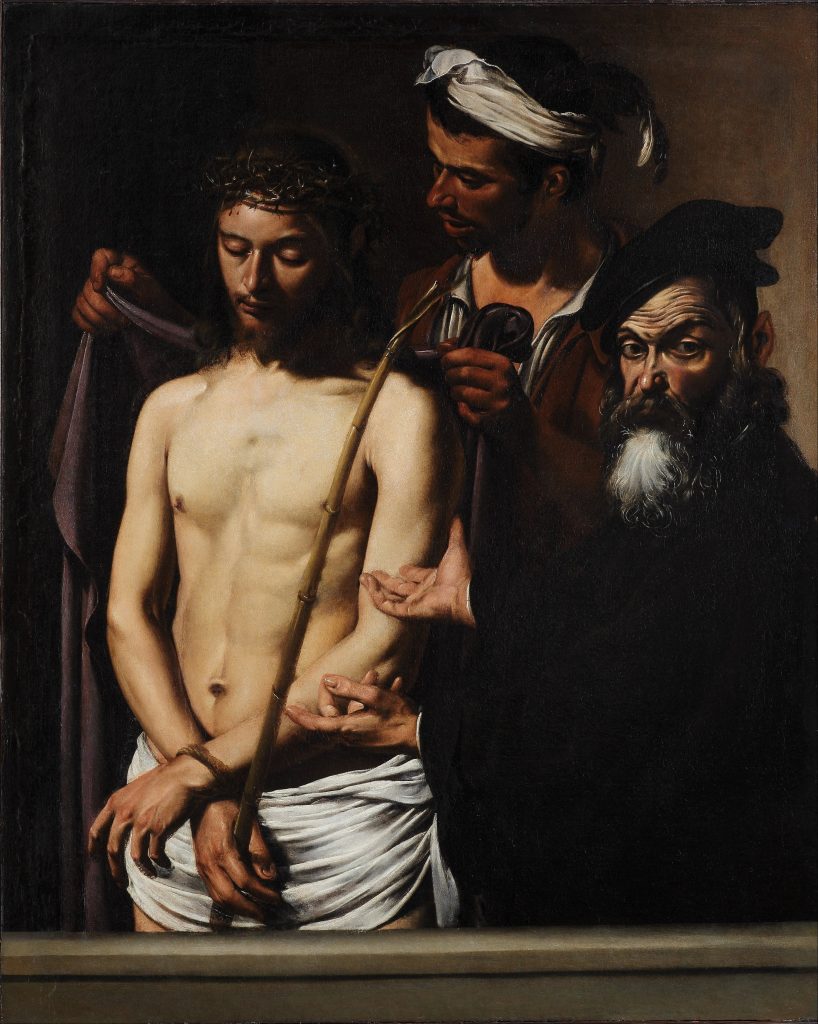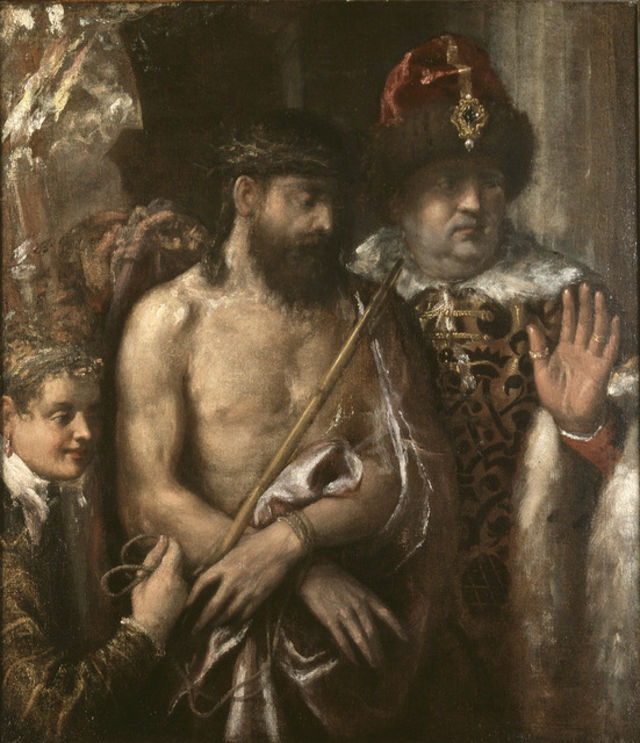Art
Emotional Realism and The Enduring Art of Caravaggio

At a small auction house in Madrid there briefly appeared a very dark, very brown painting of Christ being presented to the people before his crucifixion: “ecce homo”, says Pilate—behold the man. A dirty old varnish obscures many of the painting’s finer details; but even so, art dealers around the world thought it might be something special—nothing at auction goes unnoticed now, in the Internet age—and they were plotting between themselves how best to snap it up. Their excessive enthusiasm helped to alert the Spanish authorities who quickly then pulled the painting out of the auction and slapped an export ban on it, pending further investigation. The dealers’ enthusiasm and the authorities’ caution will be justified, though, if the painting turns out as expected to be a lost original by Michelangelo Merisi da Caravaggio (1571–1610), who has become by far the most popular of all old master painters.

It is not so surprising that some of Caravaggio’s paintings should still be flying under the radar, because, even though he was extremely famous during his short life—he inspired legions of followers in almost every corner of Europe—his style was soon disparaged by fashionable critics and his significance was written out of history. He was all but forgotten until the 20th century, so the shape of his œuvre has had to be pieced back together again by modern scholarship using whatever information could be dug out from the archives. And it happens that the painting in Madrid could already be documented: it has long been known from inventories that an Ecce Homo by Caravaggio was owned by the Viceroy of Naples, and that he shipped it from Italy to Spain in 1659. What is more, the Italian art historian Roberto Longhi—who was in large part responsible for bringing Caravaggio back to the public’s attention, having organised the first modern exhibition on the artist in Milan in 1951—had, in 1954, published a black and white photograph of an Ecce Homo that he believed to be a copy of a lost original by Caravaggio; and indeed, that photograph shows an inferior painting of the exact same composition that we now recognise in Madrid.
Until the Madrid painting has been cleaned and subjected to technical analysis, there is of course nothing but our sense of its quality to say that it too is not just another copy. But in this instance, the sense we get is extremely strong; and in the end, quality always counts more than documentation. Old documents are rarely precise, so the information they contain can all too easily be stretched and wrongly applied. For example, there is another quite different Ecce Homo [fig.2], now in the Palazzo Bianco museum in Genoa, which has over the past decades been considered by some scholars—their number is about to shrink further—to be Caravaggio’s original. This painting may have arrived in Genoa from Sicily, as copies of it have been found there; and as Sicily was under Spanish rule, it has been reasoned that the old references to “Spain” may just have meant “Spanish territories.” But it is simpler to presume that this was never the Viceroy’s painting. And now that we can look at it alongside the Madrid painting, its deficiencies are glaringly obvious.

The contrast between these two Ecce Homo paintings is instructive, because it emphasises and helps us to pinpoint the truly exceptional qualities of Caravaggio’s art. It is often said that Caravaggio was a groundbreaking “realist” painter, because he preferred to paint directly from the model (though the notion that he never used drawings is unbelievable, not just on the grounds of practicality—models are expensive, and they cannot always be relied upon—but because his more intricate compositions would have been impossible to make without a good deal of preparation). But the Genoa painting is no less the work of a “realist” than the Madrid painting, at least in the sense that whoever painted it was clearly using live models. Actually, the relative weakness of that painting has a lot to do with the artist’s dependence on his models, as you can see them just standing there, trying to hold the pose and, in the process, revealing too much of themselves, thus falling out of character. The result is a dramatic nullity (the same result as in the weird Judith and Holofernes that was found in Toulouse and controversially attributed to Caravaggio a few years ago, where the figures looked largely to have been finished-off or repainted by an artist with a clumsy hand and only a minimal understanding of the dramatic intentions behind Caravaggio’s work).
Beside the Genoa painting, the Madrid Ecce Homo suddenly seems so much more abstract. With its taut, interlocking figures, one after the next, it drums home to us what we should always have had first in mind: Caravaggio was never copying what he could see before him; he selected his material carefully, refined it in shape and tone, arranged it with perfect intelligence and presented it with the most economical touch. He was as brilliant an editor of pictorial narrative as Giotto had been; he knew what had to be shown, and he knew how to show it most importantly. On the other hand, the creator of the Genoa Ecce Homo, though certainly capable of painting the details he observed, like so many other lesser artists did not really know what such details were for.
It is interesting, this impulse of ours always to reach for that vaguest of terms, “realistic,” to compliment an artwork we admire. Why is it, despite seeing how much more abstraction went into the Madrid Ecce Homo, that we still want to call it more realistic? The answer is simple: because it is so much harder-hitting—so much more direct—in its treatment of the subject. The emotions it portrays, and that it evokes, are so precisely matched; in effect, it seems more “real” because it was more artfully conceived and executed. Indeed, it is more real; only, the reality we grasp in it is purely of sentiment (in the full, proper sense of that word).
This indicates a general problem with the terminology we use to discuss paintings. Yet in Caravaggio’s case, there is a further layer of confusion. As in the case of Vermeer—another artist rediscovered in modern times, though much less consequential during his own—it has been suggested that Caravaggio may have used lenses to make his paintings look more lifelike. It is extremely unlikely that he ever did so, for many reasons; and there is no evidence to support the theory, which rather seems to depend on the constant assertions by critics that Caravaggio’s art is in some way cinematic. Now, it is absolutely true that Caravaggio thought primarily as a dramatist when composing his pictures; and it is also relevant that he relied heavily on shadow as a dramatic device. If it helped tell the story, he would even allow his shadows to dissolve his forms away into the dark, thus disrupting our eyes’ smooth passage across them. So it was not for nothing that Nicolas Poussin, the arch-classicist, reportedly described Caravaggio as born to destroy the art of painting. But nowadays we have different expectations from pictures; we are less accustomed to the standards of classical painting, and more used to looking at photographic images in which forms quite regularly dissolve into shadow without warning. To some extent, then, Caravaggio—like Vermeer too—appeals to us because he seems to speak our language.
But it is just a coincidence; the similarity turns out to be superficial. Even if our conditioning with photography first helps us to get into Caravaggio’s pictures, we only stay with them—and not with his followers’ pictures which were painted in quite the same language—because his genius compels us to attend to his message. And the force with which he would deliver that message grew more and more urgent.
Early in his career, before c.1600, he had mostly made glamorous, sensual, humorous pictures for private patrons. From 1600 to 1604 he was mostly making giant altarpieces, all of which were rigorously composed, sometimes even in classical fashion; they were designed to be spectacular, to impress the powerful people, and it worked. But in 1605, something changed. Now that his reputation was won, he began to pare back his style. It is impossible to know to what extent this change was an artistic decision, or the result of practical necessity. Because in 1606 he had to flee Rome after killing a man, and he spent his remaining four years on the run between Naples, Malta, and Sicily. While constantly looking over his shoulder, fearing for his life, he no longer had the time to make paintings as diligently as he had before. But nor did he have the incentive. His outlook became more desperate, and so did his attitude to art. In his later paintings, his brush goes straight to the point and leaves you hanging there—just as it does in the Madrid Ecce Homo.
The Madrid rediscovery is so exciting partly because “Ecce Homo” is a subject that Caravaggio seemed destined to paint: behold the man here confronting his own death. The light hits his flesh, and that says it all—no other sensual cues were needed anymore. Caravaggio was stripping post-Renaissance art of its sugar-coating; yet somehow this would render the old sentiments more palatable to us in our secular age. Moving beyond the accidentally “cinematic” effects, we come to realise that his paintings are uniquely arresting not because they are modern—nothing could be less modern than Caravaggio’s fatalistic view of transcendence through suffering—but because they make us feel things we have not felt before. Things we did not know we could feel; perhaps, things we did not want to feel. And so we shudder. He alone among the old masters still has the power to explain religion to us.
If his sentiments were nothing new, neither is there anything so innovative about the compositional format of the Madrid Ecce Homo. It had been standard since the Renaissance—about a hundred years earlier—to show Christ before us as if we, the viewers of the painting, were the baying mob. In this way, all artists meant to make us question our conscience. But the others usually let us off, with their decorative colours and their softer lighting. Whereas Caravaggio would give us nowhere to hide from the confrontation. Only Titian, working in the previous century, ever matched Caravaggio’s intensity. And in his own late Ecce Homo [fig.3], now in the St Louis Museum of Art—a painting that was perhaps left unfinished in the artist’s studio where it might, unfortunately, have then been touched up a little by his assistants—Titian too was eager to put us in the midst of the action.
The comparison is important because the Venetian tradition to which Titian belonged, and soon dominated, was in Caravaggio’s blood. Caravaggio’s first teacher, Simone Peterzano, had been a pupil of Titian’s. And Caravaggio grew up in Lombardy studying the works of artists much greater than Peterzano, such as Lorenzo Lotto and Girolamo Savoldo, both of whom were also connected to Venice. When Federico Zuccari—then the leading academic painter in Rome—saw Caravaggio’s first public works, he reportedly declared: “What’s all the fuss about? I see here nothing more than the old ideas of Giorgione [Giorgione being another Venetian painter of the previous century, a more darkly romantic precursor to Titian].” Zuccari was jesting, surely; but it is quite possible that some of what we now choose to see as revolutionary in Caravaggio’s work, originally seemed more like revivalism. After all, Caravaggio’s contemporaries would have known very well where his art had come from. Even the deep shadows, which we now tend to think of as specifically Caravaggesque, extended from Northern Italian painters of the previous century: as well as the Venetian precedents there had been Correggio in Parma, then Correggio’s great Genoese admirer Luca Cambiaso and, most pertinently of all, the Cremonese painter Antonio Campi who had left works in Milan that the young Caravaggio would certainly have studied.

All of which just goes to show how we confuse ourselves, when we use “modernity” as a criterion to judge art. Because, which painting now looks more modern to us, Titian’s or Caravaggio’s? There is only one sensible way to respond to such a question: to dismiss it, by admitting that it does not matter. Caravaggio’s works affect us not because of their supposed modernity, but rather because they are so uncompromising in their expressions—expressions of ideas that once were common, but which are now unfamiliar enough to have gained the power to shock. Genius never does differently for the sake of it; genius differentiates itself by doing better. And in the process it makes everything seem vital, forever.





